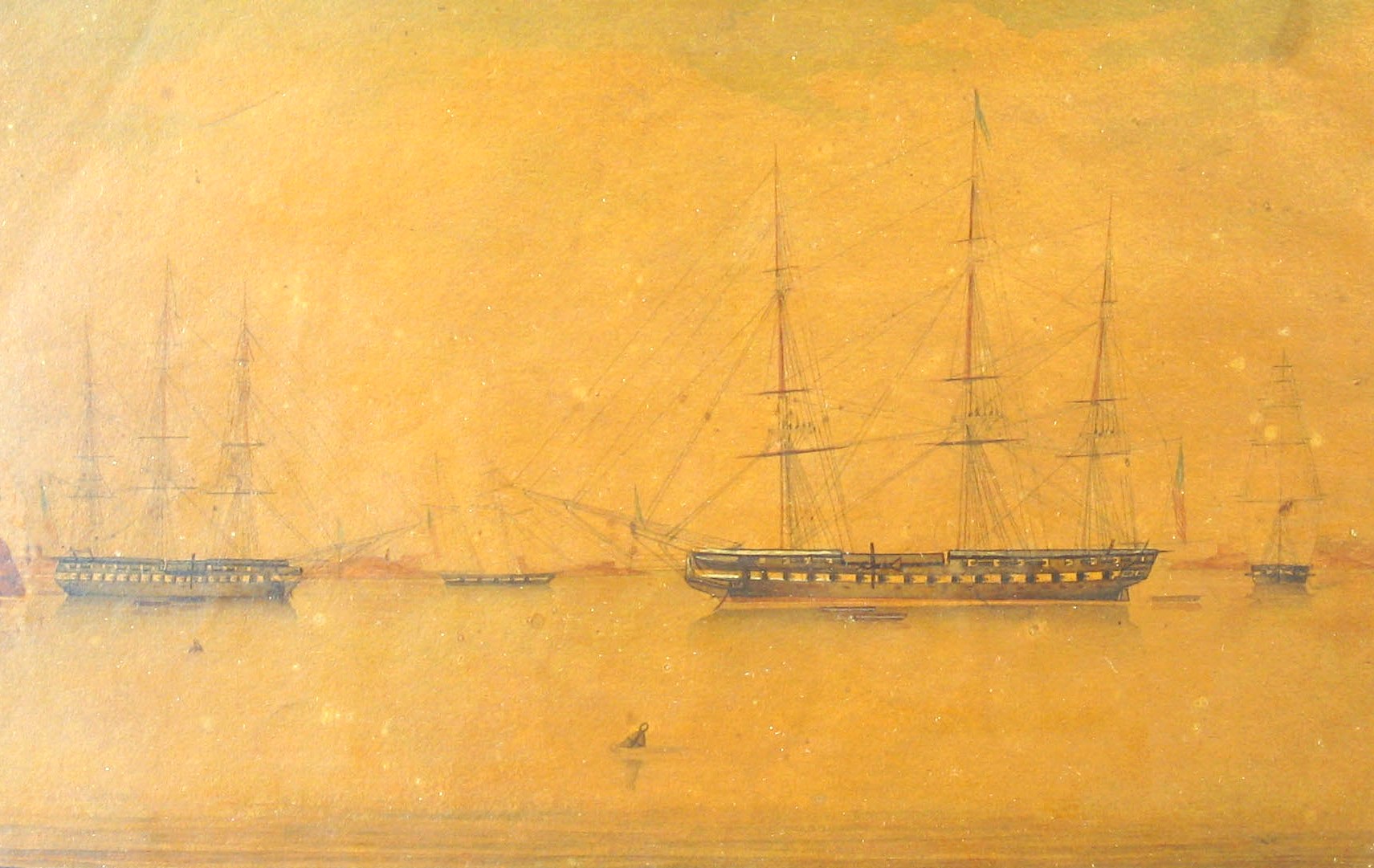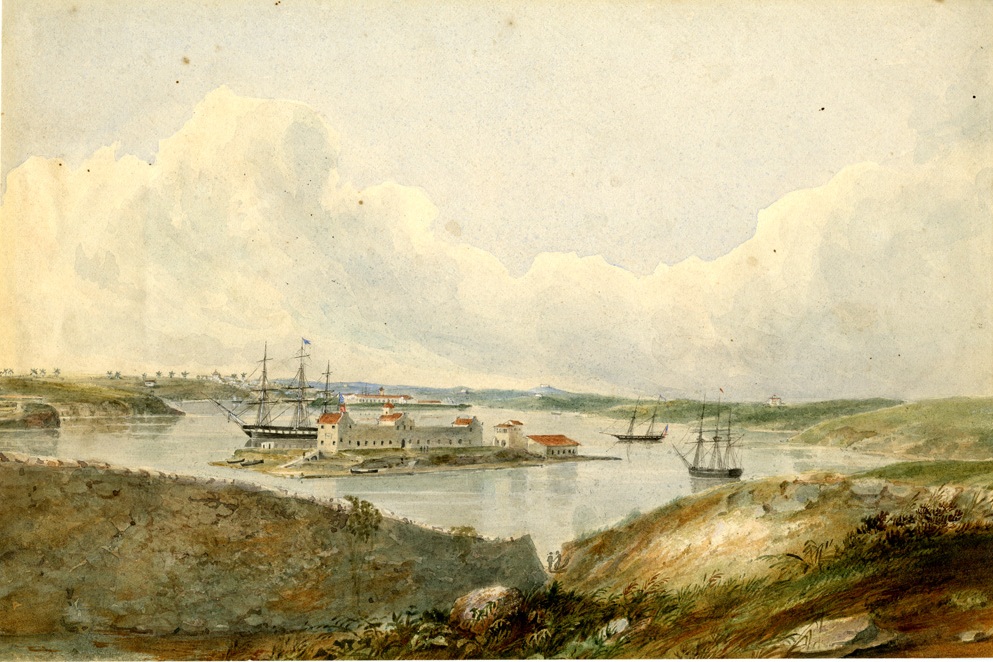Even though we strongly associate USS Constitution with sea battles of the War of 1812, the frigate spent most of its active career cruising the blue waters of the Mediterranean Sea. For most of the nineteenth century, American merchants conducted a thriving trade with the nations of the Mediterranean basin. The United States Navy maintained a squadron there to provide support and protection for American shipping, and to remind Europe that the young United States was a force to be reckoned with on the high seas.
Despite the constant commercial contacts with Spain, France, Italy, and the Levant, for most nineteenth-century Americans the Mediterranean might as well have been the moon. Any child who had paid attention to history lessons would have a head filled with the locales and events of Classical antiquity. But the land of Homer and Herodotus, of Catullus and Virgil, had changed immensely in two millennia, and most Americans who voyaged there were ill prepared to navigate the region’s modern landscapes and tumultuous politics. And yet, as evidenced by the letters and souvenirs they sent home, the places they encountered still had the power to overawe and thrill American sailors.
In the 1820s and 1830s, it became the fashion to assemble albums or portfolios containing views of the region. These became enduring mementos of the trip, and afforded the folks back home a glimpse of the exotic landscapes and peoples encountered in those far-off places. Many of these albums still exist, a testimony to their popularity.1 Most included colored engravings or hand-painted watercolor views of popular tourist spots such as Pompeii and Mount Vesuvius, ruins of ancient structures, or cityscapes of places like Livorno or Pisa.
Watercolor seems to have been the medium of choice, because unlike oils, a watercolor drawing could be executed quickly and on the spot. The vibrant colors were far more alluring than a drab pencil or ink sketch. The artists who produced these views are largely anonymous. It is likely they were locals, who produced the images for sale to foreign tourists.
At the same time, we know many naval officers were skilled artists. In fact, the ability to render topography accurately was considered a valuable attainment for officers in the pre-photography age, and many sea journals contain drawings of headlands, islands, and other landmarks useful for safely navigating the entrances to foreign ports or weathering dangerous obstructions to navigation.
Sometimes the views they produced were meant to simply record a moment in time for posterity. In 1837, Midshipman Melanchthon B. Woolsey presented “with the best respects” a watercolor and gouache painting of the American squadron at Alexandria, Egypt to Commodore Jesse Duncan Elliott. Constitution lies at anchor in the center of the painting, surrounded by the other ships of the squadron. We see nothing of the Nile city or the surrounding landscape, just the American warships in fighting trim.


“The hospital erected for the use of the British fleet is still in a good state of preservation, consisting of two parallel ranges of wards, which would comfortably accommodate six hundred patients. These two wings are connected at either end by ranges of buildings, intended for the officers of the establishment, with the necessary offices of such an institution; and throughout, the buildings are well adapted for the purposes for which they were intended. During the summer of 1835, the cholera made its appearance in our squadron, and a portion of the building was appropriated for the use of the sick; but since then they have not been occupied.”2
In 1839, the hospital was occupied by French troops wounded fighting in Algeria.
There is no way to tell if this watercolor was meant to be part of a larger folio commemorating Constitution’s Mediterranean cruise, or if, like Woolsey’s painting, it was a one-off work created to memorialize a moment. Whatever the intention, the artist captured the indolent atmosphere of the port. The green grasses of the foreground hills match up with the seasons Constitution spent at Minorca. The ship was there between February 11 and April 23, 1837, and again between October 24 and February 1, 1838, and in the Mediterranean, those are the seasons when the rains falls. The high clouds building on the horizon hint that another rain storm may be on its way. Constitution and the other ships are snugly moored in a protected anchorage, so no matter what those clouds bring, the ships will safely weather it. Whoever brought this painting home clearly cherished it as a reminder of youthful days and all the wonderful places he had seen.
1 Both the Beinecke Library at Yale University and Mystic Seaport have albums titled “Costumes of the Mediterranean.” Created by Com. Matthew Perry for his daughters in the 1830s, the books feature watercolor views of famous Mediterranean places, interleaved with images of local people drawn by Marine Sergeant Edward C. Young. The New York Public Library possess a similar book drawn and assembled by Constitution’s Gunner John Lord in the 1820s. The museum recently acquired a folio of hand-colored engravings of Pisa and Livorno assembled by one of the ship’s lieutenants in the 1830s.
2 Jonathan M. Foltz, The Endemic Influence of Evil Government: Illustrated in a View of the Climate, Topography, and Diseases, of the Island of Minorca, with Medical Statistics of a Voyage of Circumnavigation of the Globe, and an Account of Other Service, Both Ashore and Afloat (New York: J and H. Langley, 1843), 28-29.
The Author(s)
Matthew Brenckle
Research Historian, USS Constitution Museum
Matthew Brenckle was the Research Historian at the USS Constitution Museum from 2006 to 2016.
